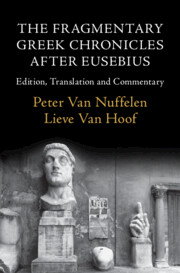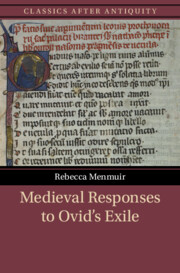Refine search
Actions for selected content:
147 results
26 - Communities of Practice in the History of English
- from Part III - Ideology, Society and the History of English
-
-
- Book:
- The New Cambridge History of the English Language
- Published online:
- 23 October 2025
- Print publication:
- 23 October 2025, pp 751-773
-
- Chapter
- Export citation
19 - The Language of Religious Texts
- from Part III - Genre and Medium in the Record
-
-
- Book:
- The New Cambridge History of the English Language
- Published online:
- 18 October 2025
- Print publication:
- 16 October 2025, pp 459-481
-
- Chapter
- Export citation

The Fragmentary Greek Chronicles after Eusebius
- Edition, Translation and Commentary
-
- Published online:
- 11 September 2025
- Print publication:
- 24 July 2025
19 - Reflections on the Interface between Word-Formation and Borrowing
- from Part IV - Interfaces
-
- Book:
- Reflections on English Word-Formation
- Published online:
- 03 October 2025
- Print publication:
- 07 August 2025, pp 148-152
-
- Chapter
- Export citation
106 - Pseudo-Eusebius, Son of Pamphilus, Chronicle
-
- Book:
- The Fragmentary Greek Chronicles after Eusebius
- Published online:
- 11 September 2025
- Print publication:
- 24 July 2025, pp 310-332
-
- Chapter
- Export citation
111 - Pseudo-Epiphanius of Salamis, Chronicle
-
- Book:
- The Fragmentary Greek Chronicles after Eusebius
- Published online:
- 11 September 2025
- Print publication:
- 24 July 2025, pp 457-474
-
- Chapter
- Export citation
Epilogue: Forging Exile
- from Part II - Becoming the Exile
-
- Book:
- Medieval Responses to Ovid's Exile
- Published online:
- 27 May 2025
- Print publication:
- 12 June 2025, pp 210-221
-
- Chapter
- Export citation
Chapter 5 - John Gower’s Visio Anglie
- from Part II - Becoming the Exile
-
- Book:
- Medieval Responses to Ovid's Exile
- Published online:
- 27 May 2025
- Print publication:
- 12 June 2025, pp 148-176
-
- Chapter
- Export citation
Introduction
-
- Book:
- Medieval Responses to Ovid's Exile
- Published online:
- 27 May 2025
- Print publication:
- 12 June 2025, pp 1-26
-
- Chapter
- Export citation
Chapter 2 - Forming Responses
- from Part I - Responding to Exile
-
- Book:
- Medieval Responses to Ovid's Exile
- Published online:
- 27 May 2025
- Print publication:
- 12 June 2025, pp 49-89
-
- Chapter
- Export citation
Chapter 1 - Ovid’s Response
- from Part I - Responding to Exile
-
- Book:
- Medieval Responses to Ovid's Exile
- Published online:
- 27 May 2025
- Print publication:
- 12 June 2025, pp 29-48
-
- Chapter
- Export citation

Medieval Responses to Ovid's Exile
-
- Published online:
- 27 May 2025
- Print publication:
- 12 June 2025
Chapter 3 - Poet and Storyteller
-
- Book:
- The Cambridge Introduction to Samuel Johnson
- Published online:
- 07 February 2025
- Print publication:
- 13 February 2025, pp 42-60
-
- Chapter
- Export citation
Utilising Generative AI in the Classics classroom
-
- Journal:
- Journal of Classics Teaching / Volume 26 / Issue 51 / Spring 2025
- Published online by Cambridge University Press:
- 03 February 2025, pp. 8-13
-
- Article
-
- You have access
- Open access
- HTML
- Export citation
Semantic information boosts the acquisition of a novel grammatical system in different presentation formats
-
- Journal:
- Language and Cognition / Volume 17 / 2025
- Published online by Cambridge University Press:
- 28 January 2025, e30
-
- Article
-
- You have access
- Open access
- HTML
- Export citation
Chapter 7 - Classics
- from Part II - Aesthetic and Cultural Contexts
-
-
- Book:
- Gerard Manley Hopkins in Context
- Published online:
- 16 January 2025
- Print publication:
- 16 January 2025, pp 60-68
-
- Chapter
- Export citation
SARDÎSTÔN: A NEW TERM FOR AN OLD CONCEPT IN RABBINIC LITERATURE
-
- Journal:
- The Classical Quarterly / Volume 74 / Issue 2 / December 2024
- Published online by Cambridge University Press:
- 26 February 2025, pp. 806-809
- Print publication:
- December 2024
-
- Article
-
- You have access
- Open access
- HTML
- Export citation
Introduction
-
-
- Book:
- Texts and Intertexts in Archaic and Classical Greece
- Published online:
- 14 November 2024
- Print publication:
- 21 November 2024, pp 1-28
-
- Chapter
- Export citation
Chapter 6 - Theoretical Implications
-
- Book:
- Verbal Medicines
- Published online:
- 29 November 2024
- Print publication:
- 07 November 2024, pp 219-247
-
- Chapter
- Export citation
Ways of reading: evaluating different approaches to reading Latin stories with a Year 9 class in a selective boys' school
-
- Journal:
- Journal of Classics Teaching / Volume 26 / Issue 51 / Spring 2025
- Published online by Cambridge University Press:
- 06 November 2024, pp. 36-43
-
- Article
-
- You have access
- Open access
- HTML
- Export citation
